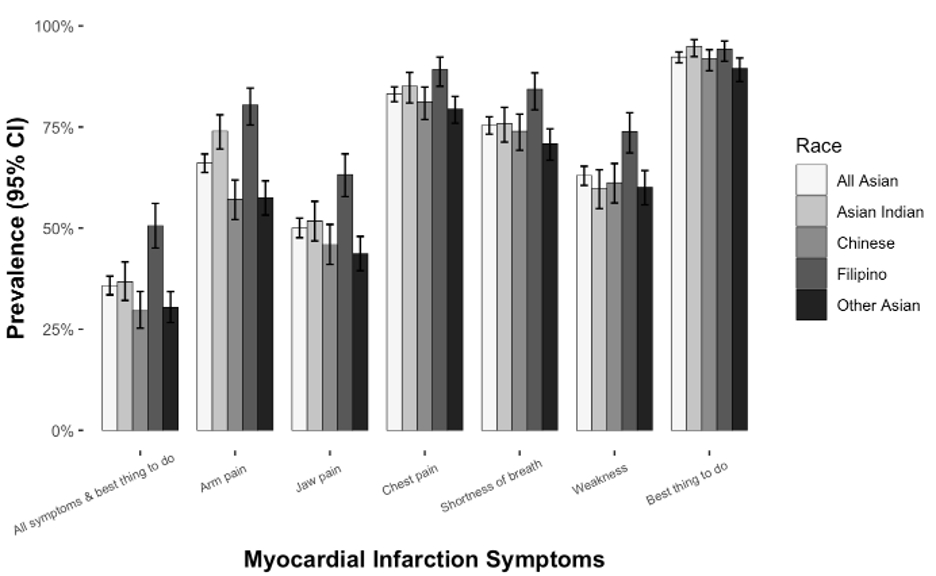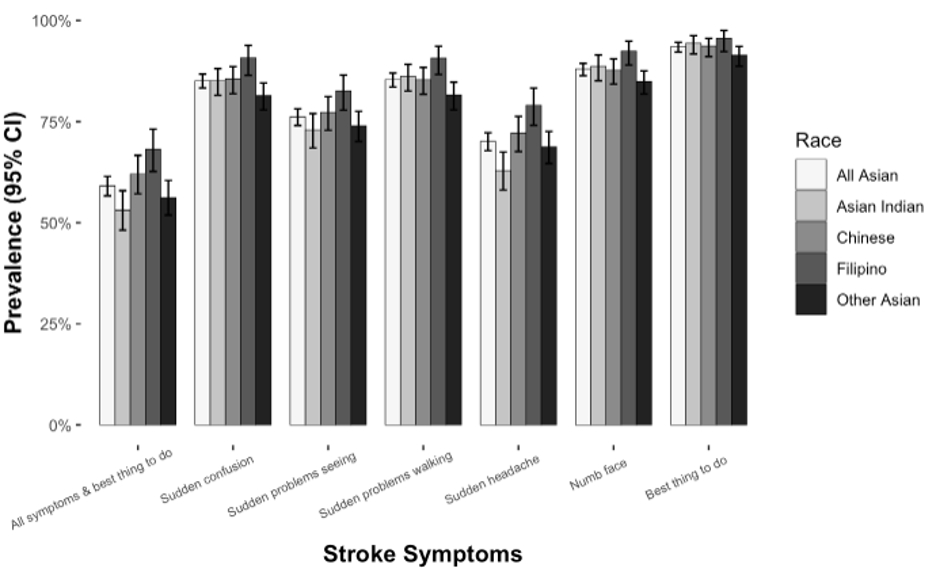Final ID: Sa4029
Awareness of Myocardial Infarction and Stroke Symptoms Among Asian American Adults: Insights from the National Health Interview Survey 2014 and 2017
Abstract Body (Do not enter title and authors here): Introduction: Stroke and Myocardial Infarction (MI) are the leading causes of death in the United States. Awareness of symptoms is vital for early recognition and prompt treatment, which can significantly improve health outcomes. This study examines MI and stroke symptom awareness among Asian American adults, a group with limited prevalence estimates on this critical health metric.
Hypothesis: There is variability in MI and stroke symptom awareness among Asian American subgroups, influenced by sociodemographic factors such as age, nativity, education, and income.
Methods: We conducted a secondary analysis using data from the 2014 and 2017 National Health Interview Survey. Our sample included 2,832 Asian adults, categorized into self-identified ethnic groups: Asian Indian, Chinese, Filipino, and "Other Asian" (an aggregate category including Japanese, Korean, Vietnamese, and others due to low sample sizes). We assessed awareness of MI and stroke symptoms and the prevalence of recognizing 9-1-1 as the appropriate subsequent action using the Rao-Scott chi-square test to account for the complex survey design.
Results: The study sample consisted of 2,832 adults (46.7 % male, 53.3% female, mean age 44.6 years [SD: 16.5 years]). Ethnic distribution was 22.0% Asian Indian, 22.5% Chinese, 20.8% Filipino, and 34.7% Other Asians. Significant disparities in symptom awareness were found among subgroups. Filipino adults exhibited the highest awareness of all five stroke symptoms (68%, 95% CI: 63%-73%) compared to Chinese (62%, 95% CI: 57%-67%), Asian Indian (53%, 95% CI: 48%-58%), and Other Asian adults (59%, 95% CI: 57%-61%). Similarly, Filipino adults also had the highest awareness of MI symptoms (51%, 95% CI: 45%-56%), compared to Asian Indian (37%, 95% CI: 32%-42%), Chinese (30%, 95% CI: 25%-34%), and Other Asian adults (30%, 95% CI: 27%-34%) (Figure).
Conclusion: There is significant heterogeneity in MI and stroke symptom awareness among Asian American adults. Filipino adults demonstrated the highest levels of knowledge regarding subsequent actions. The study underscores the need for targeted public health interventions to enhance MI and stroke symptom awareness, particularly focusing on subgroups with lower awareness.
Hypothesis: There is variability in MI and stroke symptom awareness among Asian American subgroups, influenced by sociodemographic factors such as age, nativity, education, and income.
Methods: We conducted a secondary analysis using data from the 2014 and 2017 National Health Interview Survey. Our sample included 2,832 Asian adults, categorized into self-identified ethnic groups: Asian Indian, Chinese, Filipino, and "Other Asian" (an aggregate category including Japanese, Korean, Vietnamese, and others due to low sample sizes). We assessed awareness of MI and stroke symptoms and the prevalence of recognizing 9-1-1 as the appropriate subsequent action using the Rao-Scott chi-square test to account for the complex survey design.
Results: The study sample consisted of 2,832 adults (46.7 % male, 53.3% female, mean age 44.6 years [SD: 16.5 years]). Ethnic distribution was 22.0% Asian Indian, 22.5% Chinese, 20.8% Filipino, and 34.7% Other Asians. Significant disparities in symptom awareness were found among subgroups. Filipino adults exhibited the highest awareness of all five stroke symptoms (68%, 95% CI: 63%-73%) compared to Chinese (62%, 95% CI: 57%-67%), Asian Indian (53%, 95% CI: 48%-58%), and Other Asian adults (59%, 95% CI: 57%-61%). Similarly, Filipino adults also had the highest awareness of MI symptoms (51%, 95% CI: 45%-56%), compared to Asian Indian (37%, 95% CI: 32%-42%), Chinese (30%, 95% CI: 25%-34%), and Other Asian adults (30%, 95% CI: 27%-34%) (Figure).
Conclusion: There is significant heterogeneity in MI and stroke symptom awareness among Asian American adults. Filipino adults demonstrated the highest levels of knowledge regarding subsequent actions. The study underscores the need for targeted public health interventions to enhance MI and stroke symptom awareness, particularly focusing on subgroups with lower awareness.
More abstracts on this topic:
Acceptability and Feasibility Of A Digital Health Intervention For Adults with Congenital Heart Disease
Valente Joseph, Reardon Leigh, Moons Philip, Okumura Megumi, Gurvitz Michelle, Agarwal Anushree, Banala Keerthana, Buenrostro Karina, Alano Lindsay, Duan Rong, Parang Kim, Manyan Karina, Bravo-jaimes Katia, Norris Mark
Accelerometer-Measured Sedentary Behavior and Future Cardiovascular DiseaseAjufo Ezimamaka, Kany Shinwan, Ramo Joel, Churchill Timothy, Guseh James, Aragam Krishna, Ellinor Patrick, Khurshid Shaan


